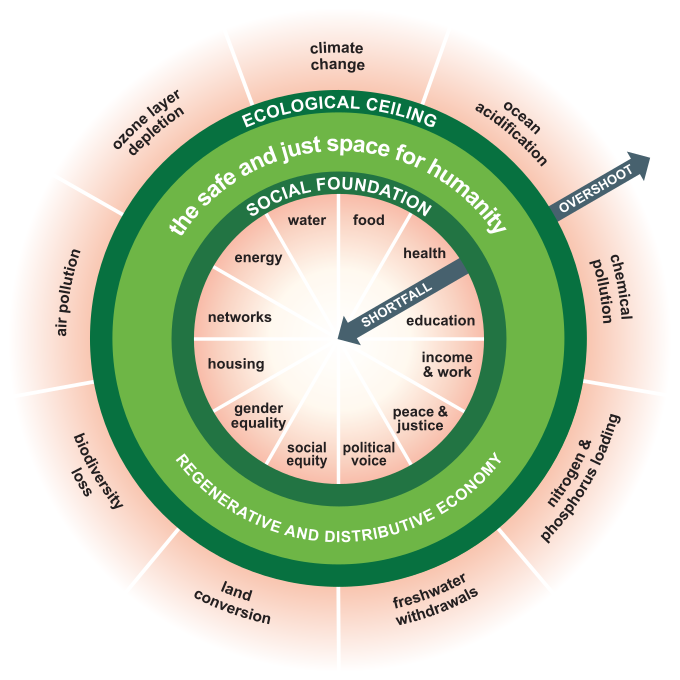A new systemic approach for a regenerative and distributive economy
“The economy has to grow, there is no other way”, is what most politicians and economists from either left or right tell us. And with that growth we can then fix inequality or pollution. But without growth there would be no jobs and no money to change anything, they say. Yet that “then” never arrives, and the destruction caused by our economies threatens our civilization as never before. The failure in our system is clear: infinite growth is impossible on a finite planet.
It’s time to abandon that suicidal paradigm and redesign our economies to align them with life on Earth, and to that means Kate Raworth provides us with a very interesting concept: donut economics.
The Donut is a compass for human prosperity in the 21st century, with the aim of meeting the needs of all people within the means of the living planet.
The doughnut is defined by 2 concentric rings:
- The social foundation: the basic needs that have to be covered to have a life of dignity and opportunity, in 12 areas internationally agreed in the Sustainable Development Goals of 2015 (water, food, health, education, income and work, peace and justice, political voice, social equality, gender equality, housing, networks and energy).
The ecological ceiling: the 9 planetary boundaries, as set by Rockstrom et al, beyond which lie unacceptable environmental degradation and potential tipping points in Earth’s systems: climate change, ocean acidification, chemical pollution, nitrogen and phosphorus loading, freshwater withdrawals, land conversion, biodiversity loss, air pollution and ozone layer depletion.
Between these two sets of boundaries lies a doughnut-shaped space that is both ecologically safe and socially just: a space in which humanity can thrive.

Here you can watch Kate explain it on a TED talk, from where we selected the audio fragment for our animation:
How can we get humanity into the Doughnut? Certainly not with last century’s economic thinking.
We need a new way of thinking, and for that Kate sets out seven ways to think like a 21st century economist. Discover more with these animations from Doughnut Economics Action Lab:
1.
Change the goal: from GDP growth to the Doughnut
Tell a New Story | Doughnut Economics Action Lab | Voice: Kate Raworth | Animation: Tom Lee www.rocket-visual.co.uk | CC BY-SA 4.0 License
2.
See the big picture: from self-contained market to embedded economy (one which recognizes its dependance upon society and the living world).
Tell a New Story | Doughnut Economics Action Lab | Voice: Kate Raworth | Animation: Tom Lee www.rocket-visual.co.uk | CC BY-SA 4.0 License
3.
Nurture human nature: we are more than just rational individualistic beings competing against each other. Let’s rediscover the power of collaboration.
Nurture Human Nature | Doughnut Economics Action Lab | Voice: Kate Raworth | Animation: Jonny Lawrence at vimedy.com | CC BY-SA 4.0 License
4.
Get savvy with systems: our economy is not a mechanical system ruled by fixed laws, but rather a dynamic complex system. It’s time to embrace that complexity.
Get Savvy With Systems | Doughnut Economics Action Lab | Voice: Kate Raworth | Animation: Ainslie Henderson, Michael Hughes, Will Anderson | Sound design: Keith Duncan | CC BY-SA 4.0 License
5.
Design to distribute: instead of pretending that growth will even it up again, let’s rethink our economies so that they pre-distribute wealth, such as the wealth that lies in controlling land, enterprise and the power to create money).
Design to Distribute | Doughnut Economics Action Lab | Voice: Kate Raworth | Animation: Mighty Oak | Sound design: Keith Duncan | CC BY-SA 4.0 License
6.
Create to regenerate: no more waiting for economic growth to clean it up. This century calls for regenerative design and a circular -not linear- economy.
Create to Regenerate | Doughnut Economics Action Lab | Voice: Kate Raworth | Animation: Ainslie Henderson | Compositing: Will Anderson | Sound design: Keith Duncan | CC BY-SA 4.0 License
7.
Be agnostic about Growth: in nature everything grows, but nothing grows forever. It’s time for mainstream economics to ditch endless GDP growth.
Be Agnostic About Growth | Doughnut Economics Action Lab | Voice: Kate Raworth | Animation: Tom Lee at Rocket-Visual | Sound design: Keith Duncan | CC BY-SA 4.0 License
Créditos
“Doughnut Economics”
Voices: KATE RAWORTH, GABINO CALÓNICO | Ilustration: LUCRECIA GÓMEZ BOSCHETTI, JESS PARKER, LAURA BLANCO, PRI PIRAJÁ, DOÑA HORTENCIA| Animation: ANTONIO BALSEIRO, MARTÍN HAAS, MATHEUS MARINS ALVARES, LUCRECIA GÓMEZ BOSCHETTI | Post-production: NAHUEL ZETA | Música: GUIDO DAM | Color: VALENTÍN JACOBO BARTHE | Production Coordinator: JEREMÍAS KURÓN | Directed by: MARTIN HAAS | Based on a TED talk by Kate Raworth | Collectively animated by @the.impossible.future
